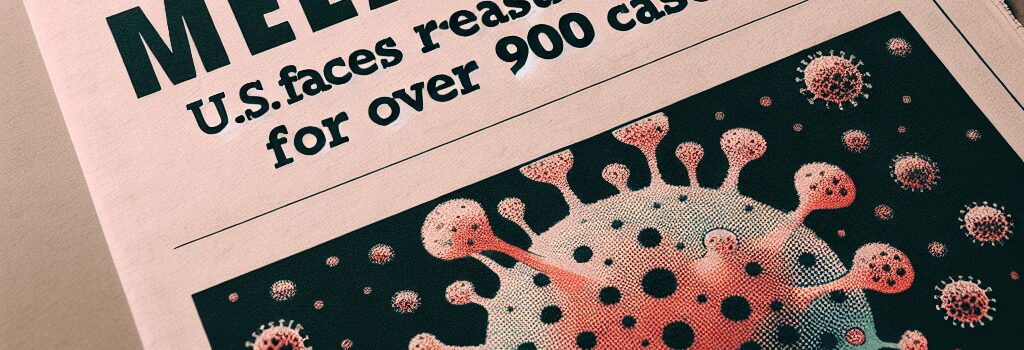U.S. Faces Measles Resurgence with Over 900 Cases

As of April 25, 2025, the United States has confirmed more than 900 measles cases in 29 states, with the majority centered in close-knit, undervaccinated communities in Texas. This early-season tally is the highest since the pre-elimination era of the 1990s and raises urgent questions about public health infrastructure, vaccine coverage, and the use of advanced modeling and AI forecasting to predict and mitigate outbreaks.
Current Outbreak Overview
- Total confirmed cases (Apr 25, 2025): 906 across 29 states
- Texas cases since late January: 664 (64 hospitalizations, 2 pediatric deaths)
- New Mexico adult fatality (unvaccinated) raises U.S. death toll to 3
- Primary demographic: unvaccinated children and teenagers
- Historical comparison: By April 26, 2019, there were 704 cases; 1994 saw 899 annual cases
Epidemiological Modeling and AI Forecasting
Recent modeling work published in JAMA employs compartmental SIR and SEIR frameworks enhanced with machine learning algorithms to forecast the course of the outbreak under varying vaccination scenarios. Measles has a basic reproduction number (R₀) estimated between 12 and 18, meaning one infected individual can infect up to 18 susceptibles in a fully susceptible population. To maintain herd immunity, at least 95% of the population must be immune via vaccination or prior infection.
The Stanford-led study projects that, if current vaccination coverage (≈92.7% among kindergartners) is maintained, the U.S. could see approximately 850,000 measles cases, 170,000 hospitalizations, and 2,500 deaths over the next 25 years. A 10% drop in MMR coverage could drive cumulative cases to over 11 million. These projections utilize ensemble methods, combining deterministic epidemic models with Bayesian parameter calibration against historical data.
Vaccination Logistics and Cold Chain Management
Effective control of measles relies on the cold chain for the Measles, Mumps, and Rubella (MMR) vaccine, which must be stored between 2 °C and 8 °C at all times to preserve viral attenuation. Public health agencies are now deploying IoT-enabled temperature loggers and blockchain-backed supply tracking to monitor vial integrity in real time. Technical specifications for these devices include ±0.5 °C accuracy, battery life exceeding 12 months, and secure MQTT communications to central dashboards.
However, underserved regions face challenges: intermittent power, limited refrigeration capacity, and insufficient data connectivity. Experts recommend solar-powered vaccine refrigerators and mesh-network gateways to ensure continuous monitoring and automated alerts when temperatures deviate beyond safe thresholds.
Global Context and International Spread
Global measles incidence has surged by over 80% since 2019, driven by outbreaks in Eastern Europe, Sub-Saharan Africa, and parts of Southeast Asia. The Centers for Disease Control and Prevention (CDC) warns that travel-linked importations will continue. Air passenger data integrated with geospatial risk modeling indicates that U.S. airports with the highest importation risk include JFK, LAX, and Hartsfield–Jackson (ATL). Enhanced screening protocols and traveler advisories are being issued to mitigate cross-border transmission.
Expert Opinions and Public Health Response
Dr. Maria Torres, an epidemiologist at Emory University, emphasizes: “We’re witnessing a convergence of declining vaccine confidence, logistical hurdles, and viral transmissibility that demands a multi-layered response. AI-driven dashboards can guide resource allocation, but community engagement and robust policy enforcement are indispensable.”
CDC Director Rochelle Walensky has called for a national emergency task force, urging states to restore MMR coverage to ≥95% through school-entry requirements and mobile vaccination clinics. The task force is evaluating digital vaccine passports and interoperable immunization information systems (IIS) to close coverage gaps.
Additional Analysis: Socioeconomic Drivers and Misinformation
Socioeconomic factors—such as healthcare access disparities, language barriers, and vaccine misinformation campaigns—play a pivotal role in undervaccination clusters. Recent network analysis of social media platforms shows coordinated disinformation pushing false safety concerns about the MMR vaccine. Tech companies are collaborating with public health authorities to introduce AI-powered content moderation filters and authoritative “trusted source” labels to counteract these narratives.
Recommendations for Strengthening Public Health Infrastructure
- Scale up interoperable IIS with real-time analytics to identify local immunity gaps.
- Invest in AI and machine learning platforms to forecast outbreak hotspots and optimize vaccine distribution.
- Enhance IoT-based cold chain monitoring with edge-computing capabilities for offline alerts.
- Implement standardized digital vaccine credentials to streamline school and travel requirements.
- Deploy targeted community outreach programs, partnering with local leaders to rebuild vaccine confidence.
“Restoring measles elimination will require the integration of cutting-edge technology, data-driven policy, and grassroots public health initiatives,” notes Dr. Alan Chen, a vaccinologist at Stanford Medicine.
Looking Ahead
Without immediate action to bolster vaccination rates and modernize public health infrastructure, the U.S. risks sliding back into endemic measles transmission. The intersection of epidemiology, cloud-based analytics, IoT, and AI presents a path forward—if policymakers and communities commit to leveraging these tools swiftly.